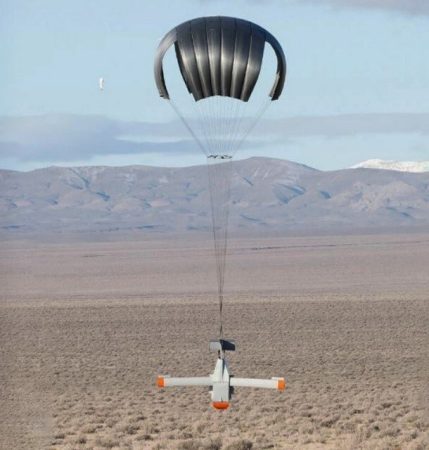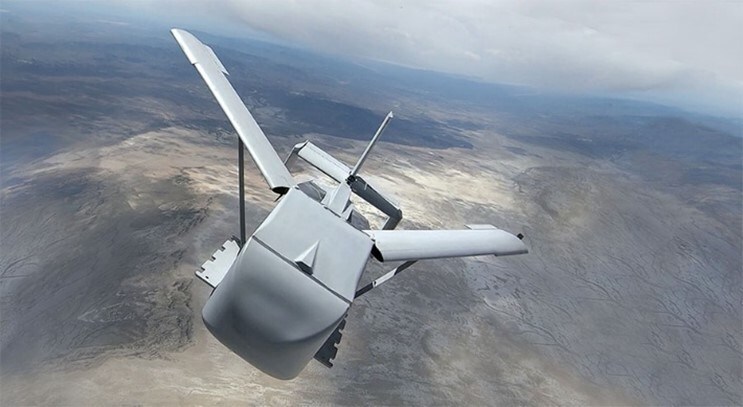The Air Force has added new self-guided gliders to deliver cargo to “high-risk environments” without putting a manned aircraft in danger.
Contractor DZYNE and the Air Force Research Laboratory unveiled the new “Grasshopper” gliders May 2, and an AFRL spokesperson told Air & Space Forces Magazine that “several dozen” units have been delivered.
Grasshopper can carry up to 500 pounds of supplies and be launched from cargo aircraft like the C-17 and C-130 using rear ramp airdrops. It can reach speeds of 109 miles per hour and glide “tens of miles” based on drop altitude, the spokesperson said.
The glider is also autonomous and capable of navigating in GPS-denied environments, allowing it to pilot itself and land with a built-in parachute.
In a release, DZYNE said it has delivered “multiple” units to the Air Force and is “currently planning for future deliveries.”

Grasshopper’s unveiling coincided with the start of SOF Week, an annual conference for special operations forces; AFRL first sought to develop the capability based on real-time feedback and rapid flight testing from Air Force Special Operations Command.
The small payload and disposable nature of the glider make it ideal for AFSOC’s mission of rapidly deploying units for precision strikes, infiltration, rescuing personnel, and intelligence gathering, often in restrictive or contested environments where nonstealthy cargo aircraft would be at high risk of being shot down.
The glider could also prove useful for the Air Force’s concept of Agile Combat Employment, enabling quick resupply of forces spread across remote islands or austere airfields under attack, without needing to send a full cargo aircraft.
“Its ability to deliver critical payloads from standoff distances while keeping our aircraft and crews out of harm’s way is a major advantage in modern operational environments,” Dr. Thomas Howell, portfolio lead at AFRL, said in a release.
DZYNE said it uses “low-cost manufacturing techniques” for the Grasshopper, keeping production costs around $40,000 per vehicle.
The Air Force has been interested in smaller-scale gliders for years now—AFRL initially tasked Silent Arrow in 2021 with scaling down its one-ton cargo glider GD-2000. The following year, U.S. Indo-Pacific Command and U.S. Special Operations Command joined up with the Joint Staff to award the company a yearlong contract to conduct operational demonstrations and refine the concepts of operation for these autonomous gliders.
DZYNE, meanwhile, has worked with the Air Force Research Laboratory before on its Unmanned Long-endurance Tactical Reconnaissance Aircraft, or ULTRA. It first test flew the Grasshopper in October 2022.
“The delivery of Grasshopper is a testament to the success of our collaboration with the Air Force in developing an autonomous resupply solution that meets the demands of contested environments,” said Matthew McCue, CEO of DZYNE Technologies. “By working closely, we were able to design and refine the Grasshopper product line into a cost-effective, high-performance aerial logistics platform.
McCue added that these self-navigating vehicles could also play a role in humanitarian aid and disaster relief efforts.
The company is currently developing a longer-range variant of Grasshopper, capable of traveling “hundreds of miles,” with plans for its debut in early 2026.
The Air Force and the Pentagon have long had the ability to airdrop supplies. For heavy-lift items weighing more than a ton, DOD introduced the Joint Precision Airdrop System in 2006. Utilizing GPS navigation, it autonomously guides steerable parachutes to one or more landing zones with precision, delivering cargo, fuel, and other supplies from altitudes as high as 25,000 feet.
The Air Force also employs Low-Cost Low Altitude (LCLA) drops for humanitarian missions, where aircraft get as low as 300 feet above ground to safely release parachuted medical kits.
These options, however, are less suitable for low-profile operations that demand swift, high-accuracy drops in remote, denied areas.
